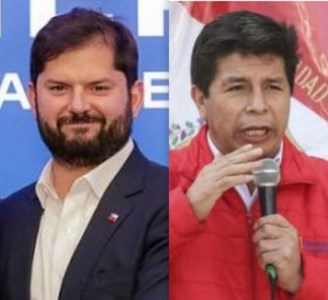

Fallen Stars: Chile, Peru
Latinvex singles out the key events in Latin America business the past decade.
BY LATINVEX STAFF
Chile, long a role model for Latin America in terms of business, and Peru, long a champion in terms of macro-economic performance, have both seen a sharp reversal in recent years.
CHILE
After years of stability, Chile in 2019 saw violent riots which ended with the government announcing a new constitution.
The massive and often violent protests closed streets, central squares and many small businesses, hotels and restaurants. Insurance premiums to protect shops and offices doubled as insurers scrambled to cover losses, Reuters reported.
Chilean businesses lost more than $1.4 billion while the city’s metro suffered nearly $400 million in damages from more than two weeks of protests in the South American country, Euronews reported. Protests also impacted the salmon industry, lithium operations, port facilities, public transportation and supply chains. Walmart — the company seen suffering most from recent violent protests — has accused the Chilean government of neglect in protecting its stores from looting, La Tercera reported.
The assembly voted to draft the new constitution has made its formal proposal and a referendum in September will decide its fate.
“Chile’s proposed new constitution omits some of the most radical ideas generated in the Constituent Assembly, but it does not fully clarify how new provisions would affect the business environment or the functioning of government,” Fitch Ratings says. “Uncertainty could also persist over how effectively the process of constitutional reform provides an institutional channel to address social tensions, especially if the proposal is rejected by the electorate.”
Added to the uncertainty was the election of leftist student leader Gabriel Boric as president of Chile in December last year. He assumed office in March this year.
The noise around the new constitution and uncertainty about new government policies has led to capital flight and many Chileans buying real estate in Miami. Uruguay is also benefiting from increased Chilean capital.
The pace of foreign outflows from individuals and non-financial companies has accelerated, reaching $50 billion at the end of last year, according to data from the central bank quoted by Grant Thornton.
“Lack of confidence in the Chilean market, a feeling of legal insecurity and lack of clear rules [and] tax reforms with great frequency. The consequence has been that Chile loses its privileged position in Latin America,” Grant Thornton says in an overview.
And the outlook isn’t getting any better. The International Monetary Fund estimates the Chilean economy will grow a lackluster 1.5 percent this year, the fourth-worst result in Latin America, according to a Latinvex analysis.
Next year, GDP will grow 0.5 percent, the lowest in the region. If the pandemic year of 2020 is excluded that will be the country’s worst result since the 2009 global crisis.
The disappointing developments come after Chile already had seen four years of economic and investment slowdowns due to the policies of President Michelle Bachelet (including tax and labor reforms harshly criticized by business), who ruled between 2014 and 2018. (She also was president during the 2006-10 period, but didn’t implement any radical policies then).
PERU
For years, Peru had been seen as booming market in Latin America, showing high economic growth and growing foreign investment.
When investment banker Pedro Pablo Kuczynski was elected president in June 2016, business optimism soared.
“By and large, the election of PPK has been viewed by the private sector as the most bullish electoral outcome of the past quarter century,” noted Franco Uccelli, Executive Director of Emerging Markets Research at JP Morgan, in a report to clients.
However, with the resignation of Kuczynski in March 2018 – less than two years into his five-year mandate – all that changed. He resigned after allegations of vote buying to avoid losing impeachment votes, which had become frequent thanks to the opposition-controlled Congress led by perpetual troublemaker Keiko Fujimori.
Kuczynski was succeeded by one of his vice presidents Martin Vizcarra, who ruled until November 2020. Vizcarra was popular for his reforms against corruption, but made a controversial move to dissolve the unpopular Congress in September that year.
Lawmakers “paid him back” two months later by ousting him in what would become an infamous week of Peru having three different presidents.
Vizcarra’s unpopular successor, Manuel Merino (who had been Speaker of Congress when Vizcarra was impeached) had to resign after a week amidst massive protests.
In the end, Congress elected Francisco Sagasti, who has a doctorate from the University of Pennsylvania and was a former head of strategic planning at the World Bank.
The one-week chaos, following a year of political uncertainty, clearly undermined Peru’s reputation among foreign direct investors.
Although Vizcarra managed to rule for more than two years, he – like Kuczynski before him – was perpetually under threat of being impeached by Congress.
After a tight election in June last year, Pedro Castillo (a teacher union leader) became president in July with the support of a Marxist party.
Since assuming office Castillo has gone from one crisis to another, naming four different prime ministers in six months, firing several ministers and repeatedly making contradictory statements about business.
The sol has fallen to record lows compared to the US dollar as investors have grown increasingly worried over both policies and the chaos surrounding Castillo.
The political chaos has hurt economic growth. In 2019, GDP grew 2.15 percent, its lowest since the global crisis in 2009. After the COVID-related decline of 11 percent, the economy bounced back by 13 percent last year but this year is expected to only grow 2.955 percent, the IMF estimates. That would place Peru among the bottom seven in Latin America.
© Copyright Latinvex
Latin America: The Top Events Past Decade
Brazil: The Top Events Past Decade
Mexico: The Top Events Past Decade












